Think about this . . .
Within ANY measure of ANY 16th 4/4 song, we'll be faced with 4.3 billion potential choices as to what variation of the rhythm we may need to play. Think about that for a very long moment! It is an awesome thought, but true.
16th 4/4 as we studied it in the Basic Dance beats lesson, is the MOST BASIC and SIMPLEST form of the rhythm, but there are 4,297,967,295 other ways to alter it.
The best, easiest and fastest way to get a handle on 16th 4/4 is to JAM! That's right! We need to get the old creative-juices flowing and JAM (or experiment) with this rhythm structure, the same way most of you have probably already been jamming with the 8th 4/4 'Rock' beat.
Get the BASIC beat going, then as it's repeated, try to alter and rearrange the basses and snares in ways that are fun and interesting to your rhythmic sensitivities. You'll get better at this gradually, as you continue to repeat, repeat, repeat.
HAVE FUN WITH IT!
The fact that there are so many variations (or permutations ) to choose from, tends to make it difficult to know WHERE to start.
To simplify this problem, start with the easiest variations first, and gradually try to continually inject, alter, and add, increasingly complex variations to the mix, as the repetitions of the pattern continue to cycle. It's a lifetime project!
TIP:
It is also productive to listen to an endless array of 16th 4/4 songs, then imitate the rhythms we're hearing within the music. Doing so will accelerate your learning curve exponentially. Your ears will work wonders, if you'll give them a chance. Do it! Learning this way is easy to do, if our ears are totally focused on the various drummers (within the recordings.)
ANOTHER TIP:
Play around with the 16th 4/4 notation on paper. Layout 16 notes, (as Xs) on the hat, and examine the rhythmic possibilities (or options) between the bass and snare. It'll be wise to keep the basses on the counts of 1 and 3, and the snares on 2 and 4, in the beginning. After that . . . almost anything we add or subtract to the pattern, will be an interesting rhythm.
I will provide a few very simple example patterns in this lesson plan. Hopefully, this will be enough to get you started. You will be on your own from that point on to JAM with this structure every day . . . always seeking out different and more interesting ideas.
But first, we need to do some serious thinking! How large a number is 4.3 billion?
4.3 billion is an awesome number! For example, if you were to begin at birth to hear one new beat every second (24 hours per day/7 days per week) . . . It would take 32 years to hear the first billion beat variations of 16th 4/4. You would need to live 132 years and do nothing else for your entire life, to hear them all. Forget about trying to learn them all! We, (all drummers, collectively) actually use only around 70 or 80 of the easiest of these beat permutations. Learning to use all of them is a virtual impossibility. There simply isn't enough time to do it.
UNDERSTANDING EXACTLY THE WAY PERMUTATIONS WORK, WILL HELP IMMENSELY.
JAM!
Jamming is a fun, easy, way to practice, and I think that far too many drum instructors tend to ignore this fundamental streamlined method of study.
As we jam and hit on ideas that cook, we will tend to remember those ideas and return to them on each new practice session.
Gradually we will build an arsenal of our own personal favorite ideas, thus forming a personalized drum solo within the framework or structure in focus.
From there, we learn to apply a few rolls or fills and BINGO, our jam will take on a very professional and polished sound. Very soon we'll begin to recognize these same ideas in the music as we listen, and it will be very easy to analyze and play along with those songs.
Actually, the music we listen to, will play a large part in the learning process, because with so many rhythmic choices, we're sure to hear many new and different ideas that are similar to, but unlike our own. It'll be easy to mimic and acquire those beats, by ear. Sometimes we can alter the entire 'feel' of a rhythm, by simply omitting or adding just one note on the bass or snare.
BEGIN WITH BASIC 16th 4/4 . . .

NOTE: The hi-hat notes may be played on the ride cymbal if you choose . . .
Get the basic 16th 4/4 pattern flowing . . . keep it going for several repetitions as a steady rhythm, then try to change it up by altering the bass or snare as in these examples . . .
EXAMPLE A:
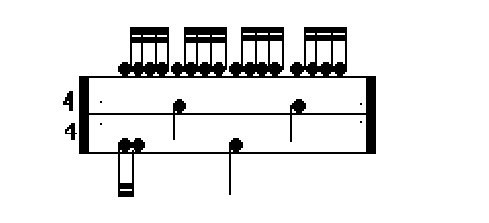
![]() VIDEO: Click here to 'Play', see, and hear the 16th rock variation video.
VIDEO: Click here to 'Play', see, and hear the 16th rock variation video.
POPUP BLOCKERS will not allow the video to appear or play. Be sure to DISABLE your popup blocker!
EXAMPLE B:
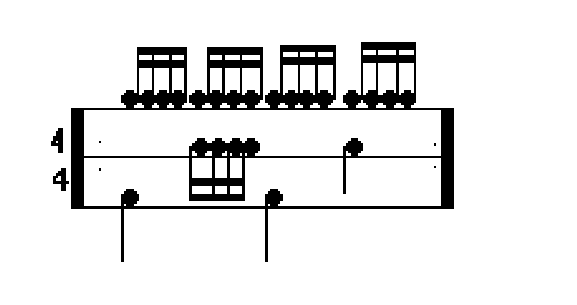
![]() VIDEO: Click here to 'Play', see, and hear the 16th rock variation video.
VIDEO: Click here to 'Play', see, and hear the 16th rock variation video.
EXAMPLE C:
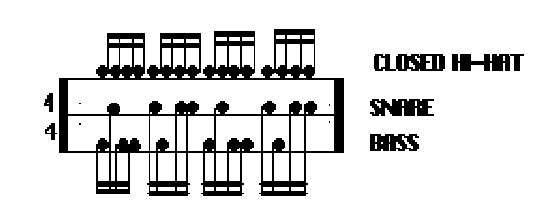
![]() VIDEO: Click here to 'Play', see, and hear the 16th rock variation video.
VIDEO: Click here to 'Play', see, and hear the 16th rock variation video.
Are you getting the idea?
Remember! You are looking at only three suggestions here. That last idea was a paradiddle between the snare and the bass. There are still 4,297,967,292 other ideas to choose from.
GO GET 'EM!!! You will never run out of new ideas. Therefore, you should never allow yourself to become embedded in a rut when improvising with this structure.
If you catch yourself falling into a rut, playing the same old rhythms over and over, then get the creative juices flowing! You must use your own imagination! If necessary, get out the old pen and some paper, then write and study a few new and different possibilities note for note, and add them to the mix.
I hate rules but there are a couple we need to keep in mind when jamming with this structure.
1. Each measure MUST accommodate 16 cymbal pulses. It is ok to 'rest' on a cymbal note but we must keep track, and continuously 'feel' all 16 pulses, with each repetition of the beat structure. In other words, any number other than 16 (pulses) will change the time-signature, and create a chaotic situation with the other band members if we are in mid-song as it occurs.
2. It is best to keep the snare 'backbeat' on the counts of 2 & 4, at least in the beginning. Later on as we gain proficiency, it is acceptable to omit an occasional backbeat, if we don't lose track of the hi-hat count (or secondary pulse.)
Well, that's it, for this lesson! However, another lesson may be necessary to explain how fills and rolling techniques are altered within this rhythm structure.
Stated very simply . . . Most of the same fills we've used with 8th 4/4 will work here too. Sometimes, we may need to double the length of the fill to make it fit the slower tempo of the beat, or we'll need to cut the speed of the fill to a point where it'll seem very draggy and slow.
To help prepare you for playing interesting fills with 16th 4/4, it may be best to make certain you can play the following two rolls at a very rapid clip, than adapt them to the 16th 4/4 beat pattern. MEMORIZE THIS ROLL PATTERN:
Practice this roll, 'rapid fire' and repetitiously, allowing no pause between repetitions. Keep it going for long durations while away from the drumset. You'll need to build coordination and speed, before adding it to the 16th rock beat.
32ND SINGLES:
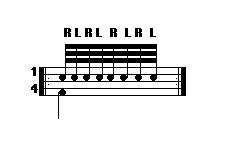
Below we have a half measure of 32nd singles. This fill will eventually become one of your favorites. The last note(s) in the pattern are a simultaneous bass and hi-hat. Be sure to play those last two notes as you practice. It will make the next step easier.

![]() Hear the fill as it should sound.
Hear the fill as it should sound.
This is the way 32nd singles will sound when used with a slow 16th rock beat (below).

16TH TRIPLETS:
6 notes on the snare for every bass note.
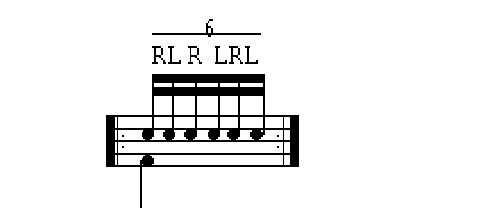
Now play two repetitions of the roll . . . six notes on the snare then six more on the hi tom.
When you can play a half measure 16th triplet fill with ease, proceed into a 16th rock beat, in the same way we studied the 32nd single roll above.
You now have two different fills that may be used with 16th rock.
![]() Now, hear all the 16th 4/4 variations (above) with a 32nd single fill.
Now, hear all the 16th 4/4 variations (above) with a 32nd single fill.
Great feelings of personal-worth begin here. Click to earn it!
Finite To Infinity
3 very important questions
IS IT POSSIBLE THAT YOUR 'NATURAL GIFT' OF RHYTHM CAN BE DOUBLED WITH ONLY A LITTLE ADDITIONAL (PREVIOUSLY UNAVAILABLE), KNOWLEDGE?
IS THERE A 'KNOWLEDGE GAP' IN YOUR OWN UNDERSTANDING OF 'RHYTHM'?
IS IT POSSIBLE TO GAIN A COMPLETE AND THOROUGH UNDERSTANDING OF 'ALL RHYTHM', WITHIN ONLY A COUPLE HOURS OF EASY, AND FASCINATING, STUDY ?
Answers: YES! YES! YES!
Get All Products Here
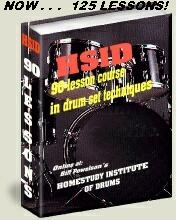
GET ALL THE PRODUCTS AT ONE LOW PRICE.
SURPRISES ABOUND!!!! . . . For those with a bit of generosity in their soul.
CLICK HERE , to see what I mean.
Intermediate & Advanced Drummers
- Drum Instructors Wanted
- Teach My Lessons and Methods
- Up to $60.00/hour
Pre-School Drummer?
Can we teach rhythm to pre-schoolers? YES!
This is a very short course, designed to help adults plant the seeds of rhythm into children of nearly any age. Click Here!!
Make CASH $$$ Now!!!

FREE ELECTRONIC BOOK BONUS (also included) BUSINESS OPPORTUNITY:
- * MAKE BIG MONEY SELLING USED DRUMSETS!
- * INSIDER HARDBALL-BUYING-TIPS AND SECRETS.
- * UNIQUE RECOVERING SECRETS
Support Us Today!!
Support this site and and gain an advetising bargain with the deal. Place a permanent ad here.

